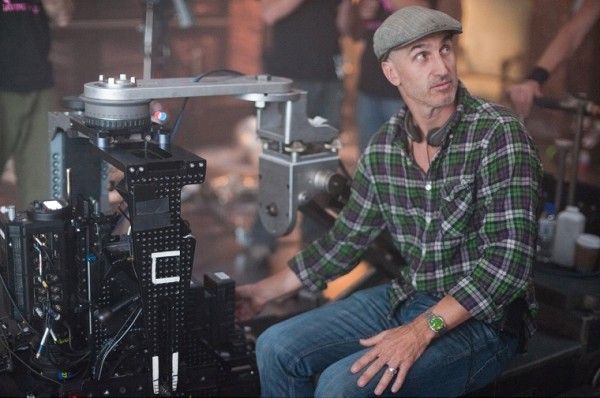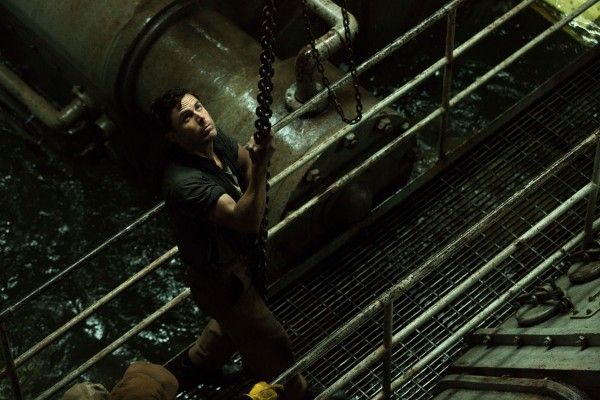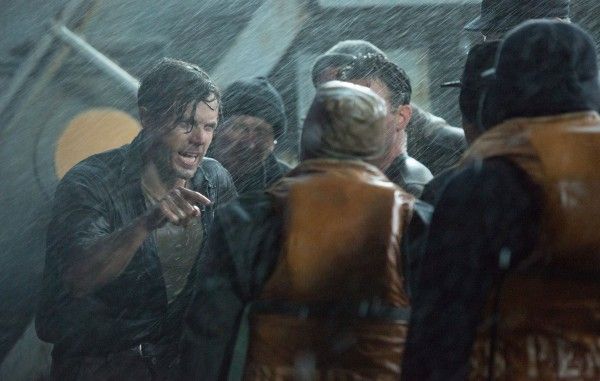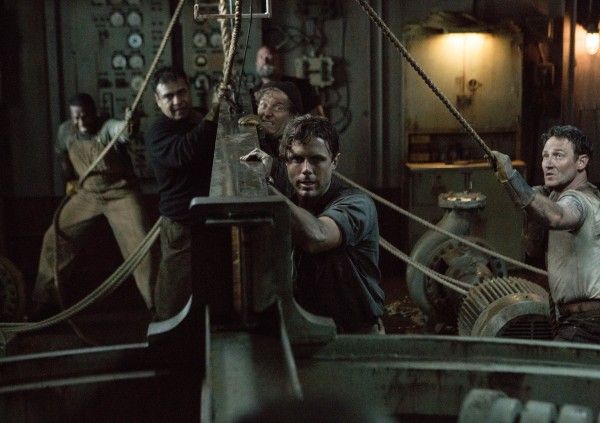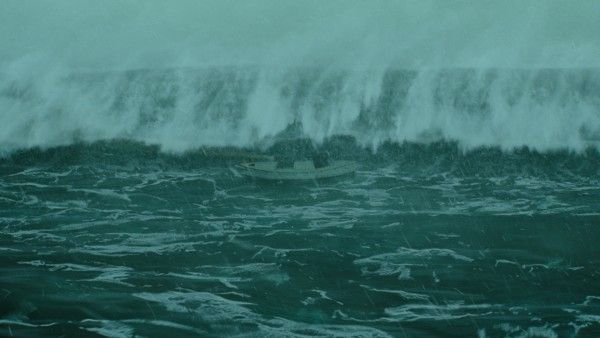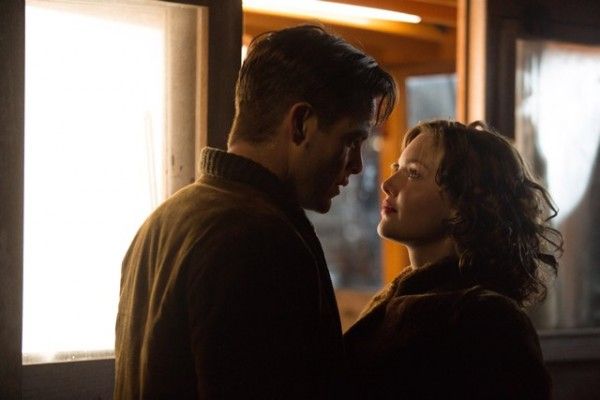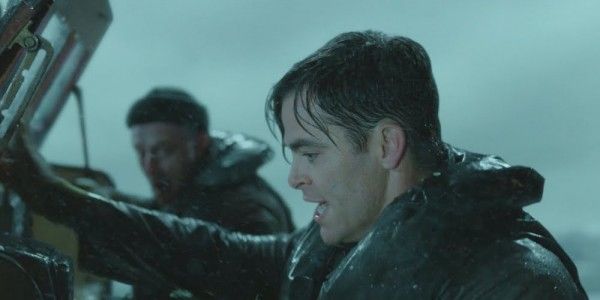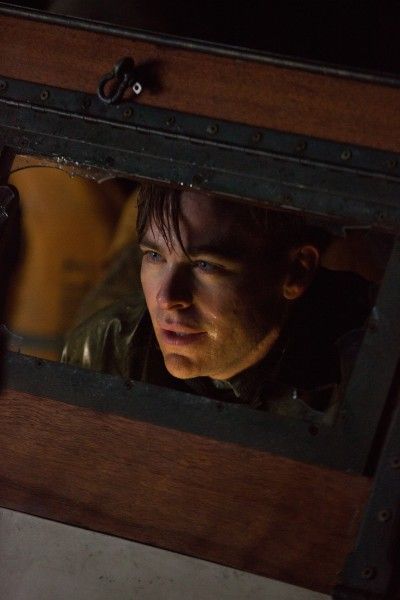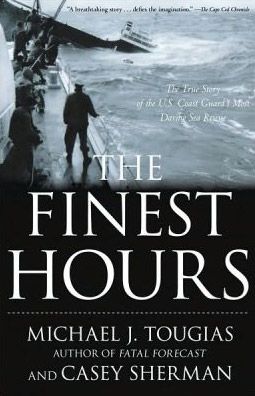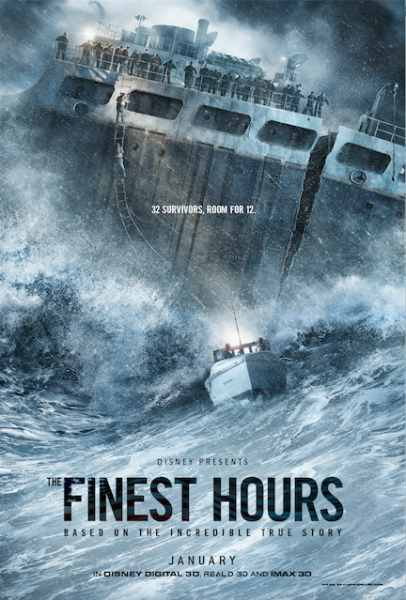Director Craig Gillespie captures the riveting true story of one of the most daring maritime rescues in the history of the U.S. Coast Guard in his aquatic action thriller, The Finest Hours, starring Chris Pine, Casey Affleck, Ben Foster, Eric Bana, and Holliday Grainger. In 1952, when a massive nor’easter strands the crew of the SS Pendleton off the coast of New England, U.S. Coast Guardsman Bernie Webber (Pine) and his three-man crew embark on a perilous mission. You should definitely plan on seeing this in IMAX 3D to experience the epic scale and immersive nature of this entertaining high stakes adventure.
At the recent press day, Collider previewed some exciting early footage of the film and spoke at length with the director. Gillespie talked about surrounding himself with experienced people who knew how to capture the action and spectacle in the most intense and visceral way possible, the impressive visual effects created by MPC, staying true to the reality of what happened, creating relatable characters, balancing the heroic action with the deeply personal moments, experiencing the intense action sequences alongside his actors on a gimbal in front of a 40 mph wind machine and freezing water, and honoring the heroism of these real men who were anti-heroes.
Check it all out in the interview below:
How did this project first come together for you?
CRAIG GILLESPIE: I didn’t know anything about this project. I’d just finished Million Dollar Arm with Disney, and they sent over a script that I knew nothing about. The log line was that it was a sea rescue, and I wasn’t honestly particularly interested in it. But then, I read the script and it was such an amazing story and it’s true. They stayed so loyal to the facts in the film that I just called the next day and said, “I’ve got to do this film.”
This film shares some DNA with the film, The Perfect Storm, in the sense that it’s set in the Boston area, a ship went out, and a rescue ensues. Did you study other films just to see how they approached water?
GILLESPIE: I did, but funnily enough, not The Perfect Storm, because I think when it was done, probably 15 or 18 years ago, it was amazing for its time, but we’ve progressed so much since then. Honestly, the film that I studied the most, which ended up being who we used, was Life of Pi. We used MPC and their effects supervisor that did the storm sequences in Life of Pi. We’ve gotten to a point now where you can just have the camera roll and do a 360 degree shot and shoot everything that you want, and they can put it in there photoreal in terms of oceans. It was really studying how much we want the camera to be on the boat with them versus separate from the boat to keep the sea movement and all of that rhythm. Even as you’d be editing now, you do these scenes, and you’ve got all this dialogue going on, and you’ve got to match the rhythm on each side as they’re talking.
Was there a cinematic mountain you had to climb when you filmed this? Which sequence was the most challenging?
GILLESPIE: I had an amazing crew. I had great people across the board, and I tried to hire very experienced people. Every day, at the end of the day, I’d say to my AD, “Well that was a big day,” and he was like, “Every day is a big day. It doesn’t stop.” Maybe in post, one sequence that has been the biggest challenge, but I think will also be probably the most intense and invigorating, is the crossing of the bar, which we couldn’t find a reference for. You’ve seen a lot of oceans and so forth going on, but this is them trying to get across a 25-foot surf in this boat. It’s all that interaction with the surf, and getting pummeled by it. The tricky part about that is people know what that 25-foot surf looks like. They’ve seen surfing videos. But, to see a boat in that, which you’ve seen in disaster situations because you can go on YouTube and see that, you have a sense of what that reality is. Trying to get that and capture that in an intense, visceral way has been the most challenging.
What were the challenges of making a film that is based on real events?
GILLESPIE: What I loved with the script is that it’s actually stayed very true to the reality of what happened. You know, they were the “B” team. There was an “A” team that was sent out and they refused to go across the bar. They took the boat from the other side of the harbor, which would take longer. These guys had to get across the bar, and they truly believed it was suicide. But, in that classic way, they did what they were told to do. Once they got out there, they lost their compass. They had no navigation, and they were flying blind in 70-foot seas. And this boat, the SS Pendleton, literally did break in half, and the chief engineer rigged up a telesystem and they drove it up under a shoal to stop it from sinking. The facts are just astounding. And then, them trying to rescue these guys. It was February in a blizzard. If they fell in the water, they were dead in two minutes, you know, hypothermia.
How did you approach balancing the heroic action that unfolds on an epic scale in this film with these deeply personal moments between the characters?
GILLESPIE: I became passionate about the script that Scott Silver worked on. What was really interesting to me was both of our leads, which is Chris Pine and Casey Affleck, who played the chief engineer on the Pendleton, were very complicated, interesting characters. They were anti-heroes, and neither of them wanted the role, both of them for different reasons. Casey’s character despised authority, and he didn’t want to be associated with having to step into those shoes. Chris’ character was a very humble, unassuming guy that needed a leader. He never wanted to be a leader. And then, he has to take that role. So that, to me, always kept it anchored. Going through those moments and how those characters would react in those moments was the most interesting part to me. Some of Chris’ stuff is just literally laying the ground of his relationship with Miriam, and seeing where his character starts and how he’s going to build from that, which all sets up how he reacts later on. Casey has three-minute monologue scene where they’re all trying to figure out what to do on the Pendleton, and ultimately he ends up having to be the one to take control. It’s honestly my favorite scene of his in the film, and it’s done in such an unusual, passive way, which you’d never expect in these raw action films.
How did you push yourself to feel as a director on this film. This is the biggest film you’ve done yet. What were the challenges to you in doing that?
GILLESPIE: I was actually really excited about it, because I’ve done commercials for 20 years, so I’ve had a chance to play with all the toys, but just not on such a long journey and scale. I felt very comfortable, I’d say. You just take it each step at a time. You’d walk in one day and we’d have a 65-foot set of the engine room that’s five stories and it’s on a gimbal and it’s got 10 feet of water in it. There was so much time and prep that went into it. We pretty much knew exactly what we were doing by the time we got to that day. I think that’s one of the luxuries of a large film is you have that prep time. By the time we got to every situation, we were ready for it, still giving the actors the opportunity to improvise within that. I’ve got to say, even though I knew it was going to be a big film, it actually ended up larger than I thought it was ever going to be.
But you are the leader of the film, what type of empathy do you have when you have to subject your actors to being on the gimbal in front of a 40 mph wind machine and water?
GILLESPIE: My empathy would be like, which honestly I would try and do, whenever we were doing a Steadicam on the 36500, which is that boat that Chris and Ben and those guys are on, I would get on the boat with them and put on a poncho. I’d look like a homeless guy and I’d sit right behind Chris or Ben with a little monitor. So, I’d be in the elements with them, because I just felt if they were going to do it, I had to step up as well. In that sense, I tried to take as much on the chin as I could with them.
There’s a Boston attitude that prevails in so many movies where we see Boston portrayed or that region portrayed.
GILLESPIE: It’s a Boston thing. I’m from Australia and I feel like it’s a bit of a commonwealth thing, too, which is this restrained emotion and this lack of communication, which I could really relate to, and that flavor. I love that, and it’s a large part of what makes these characters dysfunctional. You empathize with them because you want them to break through those barriers and be able to connect with the other characters in the film. And also, there’s this stoicism of getting the job done. What I was really happy with, and with Disney supporting it, and what was so beautiful in the script was how so much is not said, and it’s done with a look or a glance or just hanging on a moment. It’s with all the characters, not just the guys on the ship, but with the women on shore. There’s a beautiful scene with the two women where Miriam finds out something about this woman that’s a fisherman’s wife. There’s so much that happens without being said. There’s a hope that the audience is intelligent enough to track all that’s going on and how these stories relate to one another and Bernie’s journey as well. It’s there, but it’s subtle, and it’s great that we had that opportunity to play it that way.
In all your films, you always strike a good balance between action and the human drama. How do you do that?
GILLESPIE: I’m not sure exactly. I do tend to have these characters that I guess are in some way loners or dealing with obstacles that they have to confront that ultimately make them a better person in a way. I love when there’s an obstacle to overcome, even for the audience to actually empathize with that character. I find that interesting, and then, how to work around that and make them relatable. That’s something that you have to dig into the moments and into the performances and see how to play those situations that make them relatable.
You had an opportunity to meet the survivors of this story. How did that influence you?
GILLESPIE: Both Andy Fitzgerald and Mel Gouthro came to the set. They’re both alive right now. They’re the two people we got to meet. There’s just such a humbleness and a matter of factness about them that’s like, “Yeah, that’s what we did. That was our job that night.” Even reading about Bernie, he didn’t really talk about it with his family, and they sort of just shrugged about it 15 years later when they were getting some kind of honor. In some ways, they were like, “Oh yeah, that was that night that we went out.” I just love that sort of matter of factness about it. That helped reinforce what we were doing on the set.
Is there a cinematic history to this story? Was it almost made into a film in 1973?
GILLESPIE: Not that I know of. Dorothy Aufiero, who is one of the producers, was meeting Casey Sherman about another story. It might be the Whitey Bulger thing about five years ago, I think. It wasn’t going to work out, and they were coming out of the restaurant, and he says, “I got a story for you.” And he had written this book about these guys. So, to my knowledge, that was the first. Definitely, if you go to Chatham today, you’ll get, “Oh I remember that. My mother or my grandmother or my uncle told me about that story.” It was well known obviously in the town and there’s a certain pride there. Outside of that, I don’t know what else there was.
What is your own relationship to the water? Growing up in Australia, one presumes you have one.
GILLESPIE: I grew up on the water. I grew up surfing in Sydney, and we had a sailboat and Hobie Cats. So, I’m incredibly comfortable on the water in big surf, and I feel like there’s a logic and a rhythm to the ocean, which I think I could relate to with these guys. When they go out, they understand what that rhythm is, and how to deal with it, and that they have to navigate that boat across those kind of situations. I was really excited to get that on film, and that personality, and I’d be kind of tough on it.
Even though you physically didn’t take them out on that gimbal, did your actors have motion sickness?
GILLESPIE: They should have had motion sickness. Chris and the guys were in a wave pool on that boat and just rocking non-stop. It was brutal. I was sitting behind the focus puller one day and Chris was doing this amazing performance, and about halfway through it, he just threw his hands up. And I was like, “What are you doing?” and he said, “I lost it.” “What are you talking about?” He was in rhythm and he said, “Once I lose that rhythm, because the boat is just rocking and the camera is not on the boat, I can’t get it back.” I didn’t realize he’d been white knuckling it for two months.
You were working with hundreds of thousands of gallons of water in that tank. Were there any moments or days that got a little scary?
GILLESPIE: We always try and be as safe as possible, but water is quite an unpredictable force. You’re always trying to test it, and then amp it up and amp it up, and work through that and be as safe as you can, because we were dealing with such large pieces of everything really. It was 110 feet long and 65 feet high on the side of the Pendleton on a gimbal going into the pool. These guys were climbing down and jumping on that boat. It all went very smoothly.
Can you talk about what it was like working with Chris Pine, and also Casey Affleck and Eric Bana?
GILLESPIE: What I loved about working with Chris, when we started out, it was like how do we create a really interesting character here? He was an underdog in the sense that he was on the “B” team, and that’s what we found interesting and wanted to dive into, and from that aspect, that he was a real follower, that he had no desire to be the leader. He was happy taking orders. But it was something that he got grief about from his fellow workers. Delving into that and making that the sub-story to his journey really gave him a lot to work with. Then, him with his character and his mannerisms all reinforced that. It was so great to see Chris embody a character. He worked on his accent and did an amazing job with it, and did stuff that I haven’t seen him do before, which was really exciting. One of the scenes that we talked about that you got to see, which is when he says to the fisherman, “You have to go out, but you don’t have to come back in,” and there’s a level of sarcasm when one of the fisherman says, “Well maybe you should get lost then.” And he doesn’t get it. When we were first talking about that, Chris said, “I don’t know. That’s going to be hard to pull off in a believable way.” And I said, “I think your character has to pull that off. That’s your character, like he doesn’t get sarcasm. He’s a sweet guy.” And he absolutely nailed it. It makes him such an interesting character and it makes you really want to root for him.
Casey, again, is a reluctant anti-hero. What we loved about that was he hates authority in the film, and you see him bitching about it in the beginning where he’s talking to the captain and the captain won’t slow the ship down. It’s that idea of these underlings that like to rag on authority. And then suddenly he’s thrust into that position because he’s the most experienced man on the Pendleton, and he really doesn’t want that responsibility. Just seeing Casey do that journey and how to navigate that, it was really exciting to play with. Again, there’s that scene, which I mentioned, where he has that long performance. Everything that he does is unexpected and kind of wonderful in that sense.
And then, Eric came on. Eric was playing a character that is actually really insecure and basically does the wrong thing. And this guy did. He should have never ordered them to go out across that bar. It was suicidal. He was from Virginia. He’d only been there a few months and didn’t know any better. He didn’t know just the scale of what a nor’easter was. Eric Bana is typically a very imposing, strong male lead. I asked him to play it insecure and have a lot of self-doubt in his performance, and he was like, “Alright. I haven’t really done that, but I’ll give it a shot.” And he did an amazing job with it. It was great again to see him doing something that was out of his wheelhouse.
Did you cast each of them?
GILLESPIE: Chris was already attached when I came onboard. And Casey and Eric, I did.
Did you have the cooperation of the U.S. Coast Guard? Did they have to sanction this and was it easier to have that?
GILLESPIE: We had a Coast Guard technician on set giving advice and making sure we stayed true to the dialogue, the way the command center works, and how they all talk to each other. We went down to San Pedro and talked to the Coast Guard and just got a sense of their world. Honestly, which I was honored by, they’re just excited to have a Coast Guard film come out. It’s always the Air Force, the Army, and they’re just as viable as those traditions, and their domain is amazing, what they’re in control of in terms of all the waters around America and just the scale of all the different things.
Did you put your actors through a boot camp?
GILLESPIE: Their boot camp was this movie. It was so physically demanding. Chris had to jump in. His first two weeks were on that boat with these long speeches in the water, bouncing around with freezing rain on him. It was just a brutal, long, arduous thing. I mean, he shined. He did an amazing job with it. They were freezing their asses off every take.
How long did you shoot?
GILLESPIE: Three months. Seventy days.
Can you talk about your collaboration with Carter Burwell?
GILLESPIE: I was so happy that he wanted to do the film. He was my first and only choice. What I love about Carter’s work is, as I said to him, he never picks a lane. His music is always so incredibly complex. All at once, it’s hopeful, dramatic, sad and whimsical, and it’s playing all these different notes in the same moment, which is kind of what I try to do with the characters when they’re performing. You’re never quite sure exactly what they’re feeling or where they’re coming from. It’s a complexity that I try and get in there for better or worse. When we temped the movie, I ended up already using a lot of Carter’s music, just as we were temping the film. I couldn’t imagine anybody else. I got to fly to New York and meet with him and show him the film. Typically, you’ll go through the protocol and then we’ll see what his people say, but I just went to lunch with him and I said, “Alright, I want you to do this film.” He said, “I’ll do the film.” And I was like, “Great!” And that was that conversation. The first thing he sent over was the opening scene when Bernie and Miriam meet, and it’s their love theme. It literally just brought tears to my eyes because it was so restrained and simple and poetic. And then, from that, it gets blown out into the rest of the film. I was just so happy that he was available, and he could do it and wanted to do it.
This is such a universal story. What does courage mean to you?
GILLESPIE: For me, and what is so great with these guys, is that they’re burdened with this responsibility and they don’t hesitate. They just do it. They put others before themselves. They just get the job done, and they don’t think about the consequences. That, to me, is truly heroic. And I think that’s what makes the film so interesting, because everybody would be like, “Alright, what would I do in that situation? How would I behave? Would I be Casey’s character or would I be the Brown character that was like ‘every man for himself’ and getting off the boat?” You hope [you’d be heroic], but nobody actually really knows until they’re faced with those consequences how they’ll behave.
The Finest Hours opens January 29th in Digital 3D, Real D 3D, and IMAX 3D.

